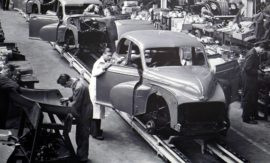Intended learning outcomes: Present in detail design and specification of a product in an ETO environment as five phases of potential cooperation between R&D and Engineering along the value chain. Explain the ETO businesses of industrial steam turbines and high-rise elevators.
It is practical to classify the means utilized, among other criteria, by five consecutive phases of potential cooperation between R&D and Engineering along the value chain, as shown along the green line in Figure 7.5.1.1. Thereby, the typical market-driven PD differs from customer-driven PD (i.e. when a customer order triggers conventional PD activities). Also, customer-driven PD and (pre- and post-award) OSE differ in their primary scope: the design of a standard component and the customization of a component, respectively.
Figure 7.5.1.1 Design and specification of a product in an ETO environment (green line): Five phases of potential cooperation between R&D and Engineering along the value chain
[SöWe17] describes several formalized practices and tools used in two companies. These means allow the companies both to fulfil actual customer requirements via OSE and, regularly, to integrate the newly developed product specifications into the standard solution space for future reuse. In both companies, there are also informal means of communication. These are just as important. However, their investigation is not within the scope of this Section.The Industrial Steam Turbines business unit of General Electric (GE) has about 90 R&D and OSE engineers. Engineering is active during 70% of the delivery lead time. Almost all of the 10-20 orders per year follow specific customers’ requirements such as output capacity, pressure and temperature levels for the turbine. Each engineering project is divided into subtasks according to knowledge domains and to specific components of the final product. The assembly of the different modules also requires order-specific interfaces. Such complexity results in, on average, more than 6,000 (sic!) man hours per project. GE often benefits from quick retrieval of product-related information out of ad-hoc repositories, and developing search engines aimed at navigating through the company’s product solution space and relevant design instructions. R&D and Engineering cooperate using several formalized organizational practices and IT tools. R&D and Engineering jointly develop and maintain these tools and processes. Overall, there is a high degree of cooperation between the two departments.
The high-rise elevator business unit is a relatively small entity within Schindler Europe and Asia-Pacific. The use of a sophisticated product configurator allows a high degree of standardization, and therefore offers high efficiency of the order acquisition and fulfilment process. This IT tool was developed in view of the substantial number of orders sold per year. It enables identification of commonalities in the customer’s requests, and in turn expansion of the company’s standard product solution space. For many orders, the classical make-to-order approach is adequate. If customers’ requirements entail a non-standard solution, the Engineering team attempts to generate new designs and associated technical solutions. The majority of orders require less than 100 hours of engineering work. Very few tools are used for cooperation between R&D and Engineering. Most of the practices and IT tools are used within the high-rise elevator business unit, often only within Engineering. Overall, and in particular during the OSE process, there is only a low degree of cooperation between R&D and Engineering. Also, phase 3 in Fig. 7.5.1.1 is not used by Schindler.
Furthermore, the majority of the means used by GE are organizational practices and short-term oriented, whereas for Schindler they are IT tools and long-term oriented.
Course section 7.5: Subsections and their intended learning outcomes

7.5 Cooperation between R&D and Engineering in ETO Companies
Intended learning outcomes: Describe different means used for cooperation between the R&D and the order-specific engineering departments. Present the portfolio of cooperation types between R&D and engineering in ETO companies.

7.5.1 Different Means Used for Cooperation between the R&D and the Order-specific Engineering Departments
Intended learning outcomes: Present in detail design and specification of a product in an ETO environment as five phases of potential cooperation between R&D and Engineering along the value chain. Explain the ETO businesses of industrial steam turbines and high-rise elevators.

7.5.2 Two Fundamental Cooperation Types in ETO Companies
Intended learning outcomes: Identify influencing factors of cooperation between R&D and Engineering. Disclose two fundamental cooperation types in ETO companies.

7.5.2b The Portfolio of Cooperation Types between R&D and Engineering in ETO Companies
Intended learning outcomes: Explain the portfolio of cooperation types between R&D and Engineering in ETO companies.
